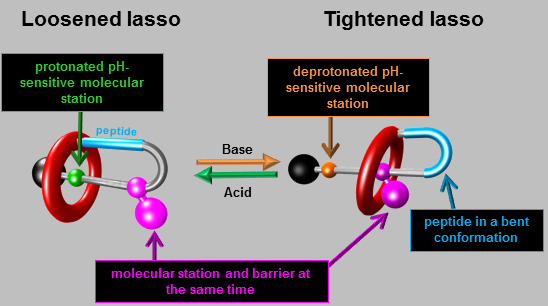A pH-Sensitive Peptide-Containing Lasso Molecular Switch
Abstract
:1. Introduction

2. Results and Discussion
2.1. Synthetic Strategy to Synthesize the Lasso Compounds
2.2. Preliminary Results Obtained on a Non-Peptidic Lasso Molecular Switch

2.3. Extension to the Preparation of a pH-Sensitive Tripeptide-Containing Lasso Molecular Switch
2.3.1. Synthetic Part
2.3.2. Studies of the Equilibrium between the Unthreaded Compound 12u and the Lasso 12
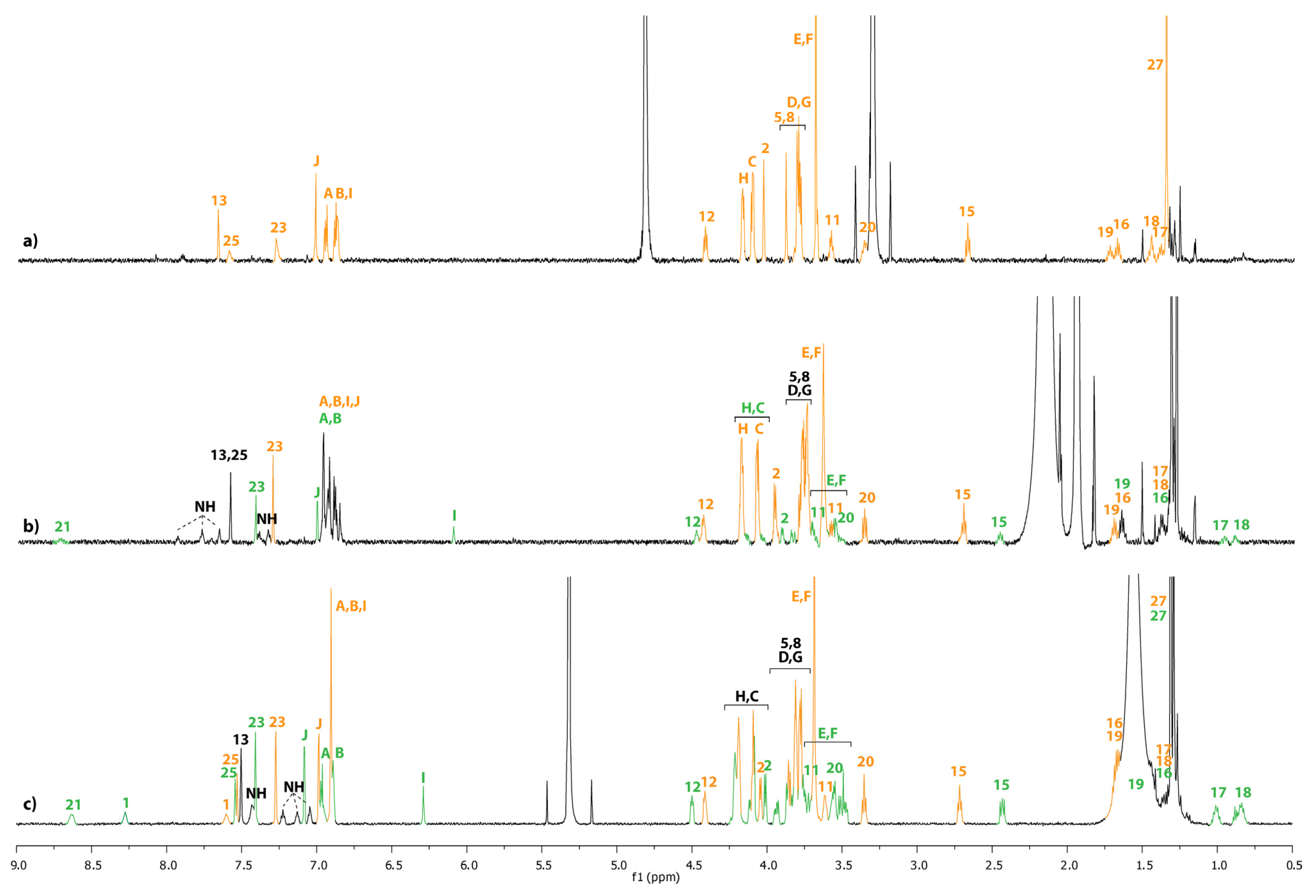
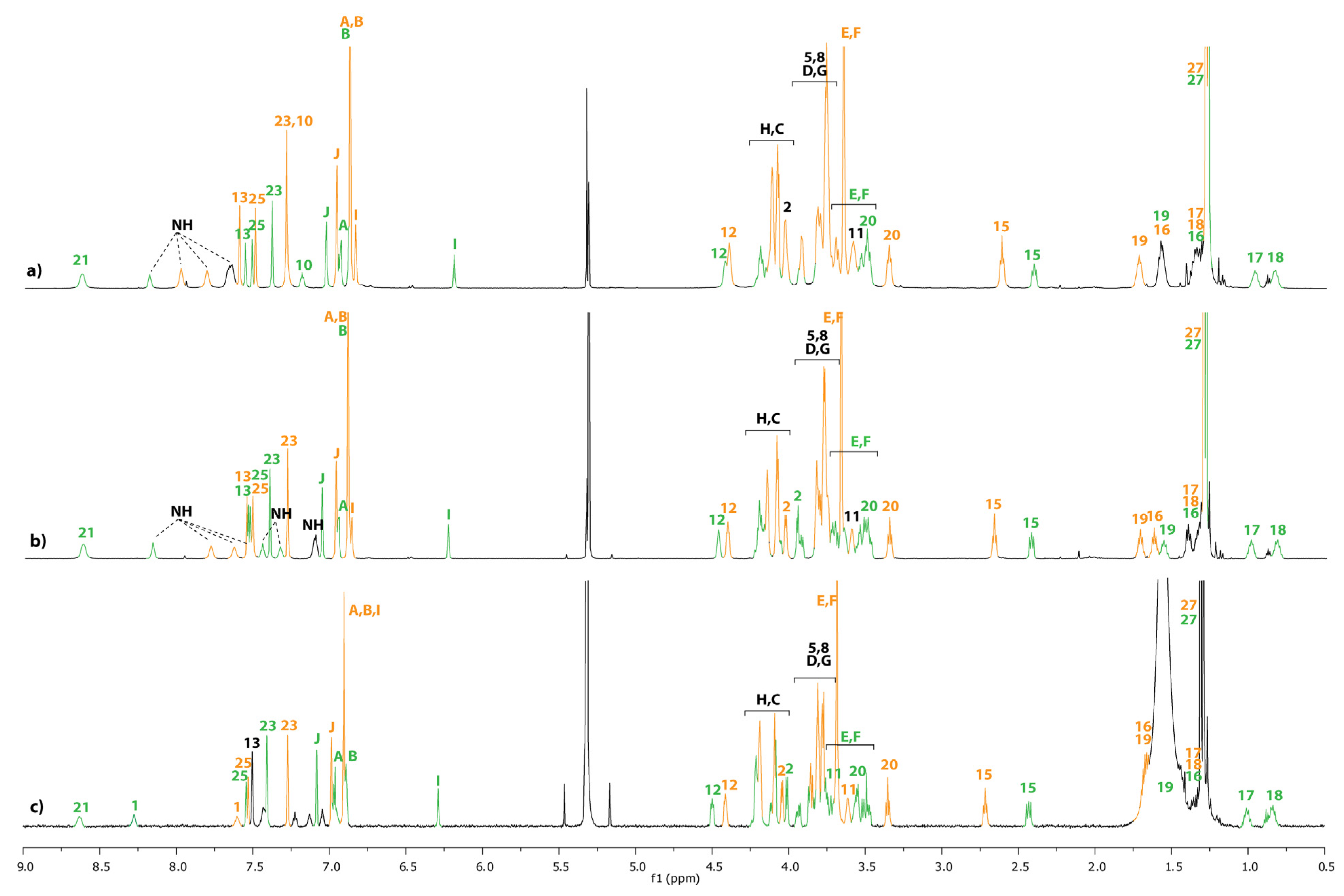
| Entries | C (12/12u) [M] | T (K) | CD3OD | CD3CN | CD2Cl2 | C2D2Cl4 |
|---|---|---|---|---|---|---|
| 1 | 5.10−2 | 298 | - | - | 35/65 | - |
| 2 | 5.10−3 | 298 | - | - | 44/56 | - |
| 3 | 5.10−4 | 298 | 0/100 | 25/75 | 47/53 | 55/45 |
| 4 | 5.10−4 | 318 | - | - | - | 38/61 |
| 5 | 5.10−4 | 328 | - | - | - | 29/71 |
| 6 | 5.10−4 | 338 | - | - | - | 14/86 |
| 7 | 5.10−4 | 348 | - | - | - | 8/92 |
2.3.3. 1H-NMR Investigation of the Molecular Machinery between Lasso Compounds 13 and 14
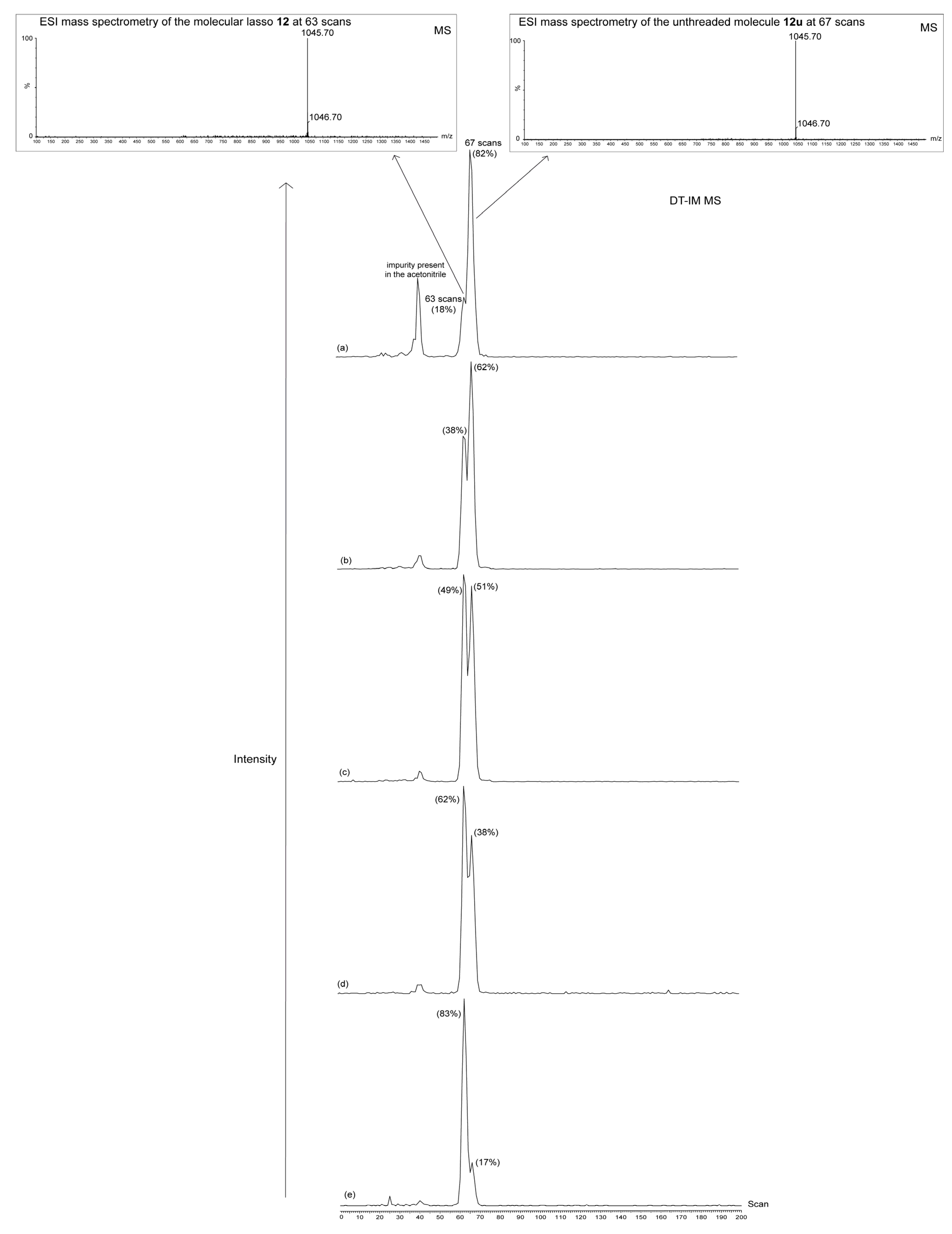


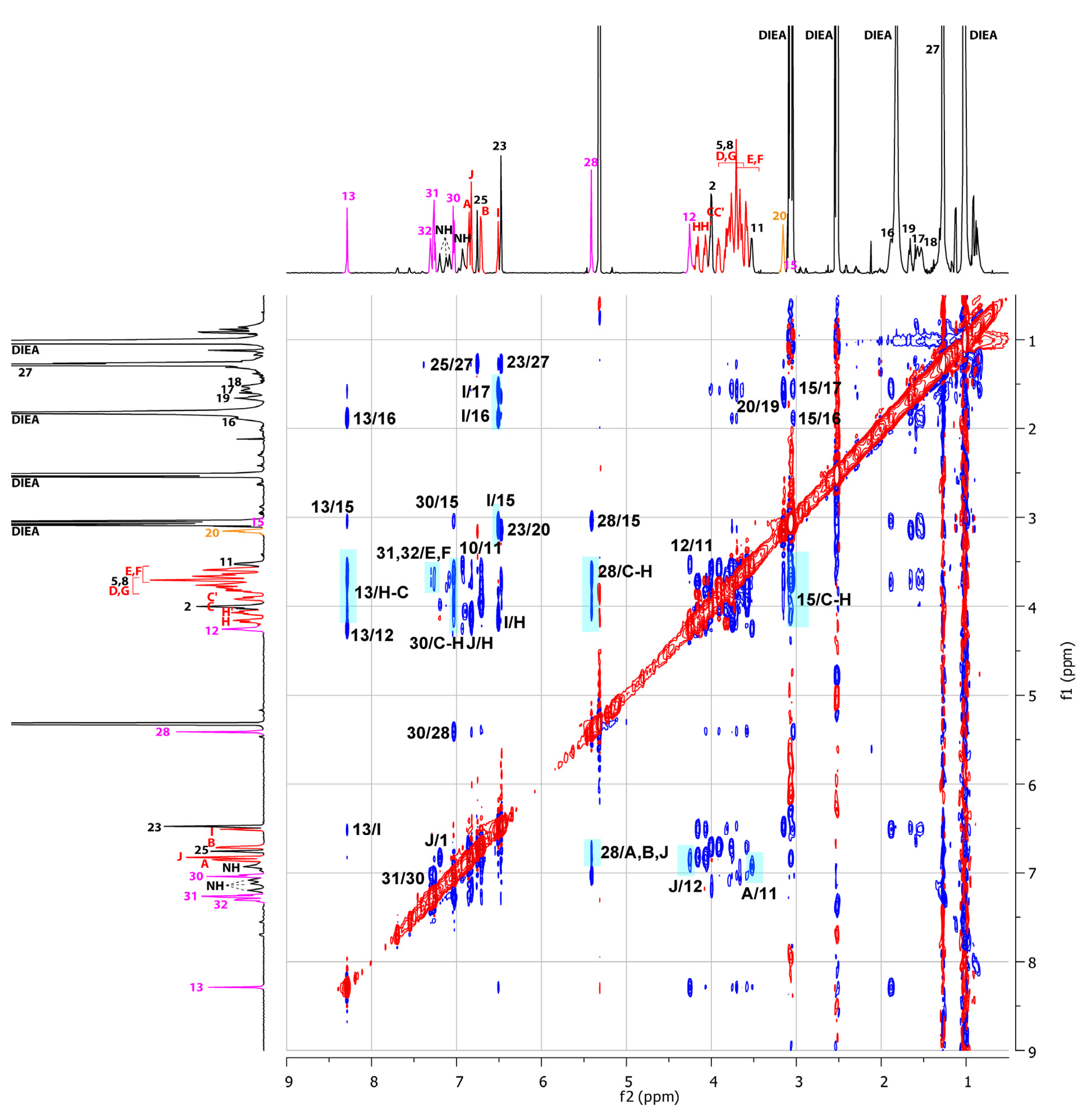
3. Experimental
3.1. General
3.2. Synthesis and Characterizations of [1]Rotaxanes 13 and 14
3.3. Synthesis and Characterizations of the Uncomplexed Threads 13u and 14u
4. Conclusions
Supplementary Materials
Conflicts of Interest
References
- Knappe, T.A.; Linne, U.; Zirah, S.; Rebuffat, S.; Xie, X.; Marahiel, M.A. Isolation and structural characterization of capistruin, a lasso peptide predicted from the genome sequence of Bukholderia thailandensis E264. J. Am. Chem. Soc. 2008, 130, 11446–11454. [Google Scholar]
- Rosengren, K.J.; Blond, A.; Afonso, C.; Tabet, J.C.; Rebuffat, S.; Craik, D.J. Structure of thermolysin cleaved microcin J25: Extreme stability of a two-chain antimicrobial peptide devoid of covalent links. Biochemistry 2004, 43, 4696–4702. [Google Scholar] [CrossRef]
- Rebuffat, S.; Blond, A.; Destoumieux-Garzon, D.; Goulard, C.; Peduzzi, J. Microcin J25, from the macrocyclic to the lasso structure: Implications for biosynthetic, evolutionary and biotechnological perspectives. Curr. Prot. Pept. Sci. 2004, 5, 383–391. [Google Scholar] [CrossRef]
- Helynck, G.; Dubertret, C.; Mayaux, J.F.; Leboul, J. Isolation of RP71955, A new anti-HIV-1-peptide secondary metabolite. J. Antibiot. 1993, 46, 1756–1757. [Google Scholar] [CrossRef]
- Adelman, K.; Yuzenkova, J.; La Porta, A.; Zenkin, N.; Lee, J.; Lis, J.T.; Borukhov, S.; Wang, M.D.; Severinov, K. Molecular mechanism of transcription inhibition by peptide antibiotic Microcin J25. Mol. Cells 2004, 14, 753–762. [Google Scholar] [CrossRef]
- Duquesne, S.; Destoumieux-Garzon, D.; Zirah, S.; Goulard, C.; Peduzzi, J.; Rebuffat, S. Two enzymes catalyze the maturation of a lasso peptide in Escherichia coli. Chem. Biol. 2007, 14, 793–803. [Google Scholar] [CrossRef]
- Clarke, D.J.; Campopiano, D.J. Maturation of McjA precursor peptide into active microcin MccJ25. Org. Biomol. Chem. 2007, 5, 2564–2566. [Google Scholar] [CrossRef]
- Salomon, R.; Farias, R. Microcin 25, A novel antimicrobial peptide produced by Escherichia coli. J. Bacteriol. 1992, 174, 7428–7435. [Google Scholar]
- Destoumieux-Garzon, D.; Duquesne, S.; Peduzzi, J.; Goulard, C.; Desmadril, M.; Letellier, L.; Rebuffat, S.; Boulanger, P. The iron-siderophore FhuA is the receptor for the antimicrobial peptide microcin J25: role of the microcin Val11-Pro16 β-harpain region in the recognition mechanism. Biochem. J. 2005, 389, 869–876. [Google Scholar] [CrossRef]
- Bierbaum, G.; Jansen, A. Tying the knot: making of lasso peptides. Chem. Biol. 2007, 14, 734–735. [Google Scholar] [CrossRef]
- Cheung, W.L.; Pan, S.J.; Link, A.J. Much of the microcin J25 leader peptide is dispensable. J. Am. Chem. Soc. 2010, 132, 2514–2515. [Google Scholar] [CrossRef]
- Ferguson, A.L.; Zhang, S.; Dikiy, I.; Panagiotopoulos, A.Z.; Debenedetti, P.G.; Link, A.J. An experimental and computational investigation of spontaneous lasso formation in microcin J25. Biophys. J. 2010, 99, 3056–3065. [Google Scholar] [CrossRef]
- Blond, A.; Peduzzi, J.; Goulard, C.; Chiuchiolo, M.J.; Barthelemy, M.; Prigent, Y.; Salomon, R.A.; Farias, R.N.; Moreno, F.; Rebuffat, S. The cyclic structure of microcin J25, a 21-residue peptide antibiotic from Escherichia coli. Eur. J. Biochem. 1999, 259, 747–755. [Google Scholar]
- Bayro, M.J.; Mukhopadhyay, J.; Swapna, G.V.T.; Huang, J.Y.; Ma, L.-C.; Sineva, E.; Dawson, P.E.; Montelione, G.T.; Ebright, R.H. Structure of antibacterial peptide Microcin J25: A 21-residue lariat protoknot. J. Am. Chem. Soc. 2003, 125, 12382–12383. [Google Scholar]
- Rosengren, K.J.; Clark, R.J.; Daly, N.L.; Göransson, U.; Jones, A.; Craik, D.J. Microcin J25 has a threaded sidechaine-to-backbone ring structure and not a head-to-tail cyclized backbone. J. Am. Chem. Soc. 2003, 125, 12464–12474. [Google Scholar]
- Wilson, K.-A.; Kalkum, M.; Ottesen, J.; Yuzenkova, J.; Chait, B.T.; Landick, R.; Muir, T.; Severinov, K.; Darst, S.A. Structure of microcin J25, a peptide inhibitor of bacterial RNA polymerase, is a lassoed tail. J. Am. Chem. Soc. 2003, 125, 12475–12483. [Google Scholar] [CrossRef]
- Everts, S. Lassoing your target. Chem. Eng. News 2010, 88, 38–39. [Google Scholar]
- Knappe, T. A.; Linne, U.; Robbel, L.; Marahiel, M.A. Insights into the biosynthesis and stability of the lasso peptide capistruin. Chem. Biol. 2009, 16, 1290–1298. [Google Scholar] [CrossRef]
- Pavlova, O.; Mukhopadhyay, J.; Sineva, E.; Ebright, R.H.; Severinov, K. Systematic structure-activity analysis of microcin J25. J. Biol. Chem. 2008, 283, 25589–25595. [Google Scholar] [CrossRef]
- Pan, S.J.; Link, A.J. Sequence diversity in the lasso peptide framework: discovery of functional microcin J25 variants with multiple amino acid substitutions. J. Am. Chem. Soc. 2011, 133, 5016–5023. [Google Scholar] [CrossRef]
- Knappe, T.A.; Manzenrieder, F.; Mas-Moruno, C.; Linne, U.; Sasse, F.; Kessler, H.; Xie, X.; Marahiel, M.A. Introducing lasso peptides as molecular scaffolds for drug design: engineering of an integrin antagonist. Angew. Chem. Int. Ed. 2011, 50, 8714–8717. [Google Scholar] [CrossRef]
- Leigh, D.A.; Murphy, A.; Smart, J.P.; Slawin, A. M.Z. Glycylglycine rotaxanes–The hydrogen bond directed assembly of synthetic rotaxanes. Angew. Chem. Int. Ed. 1997, 36, 728–732. [Google Scholar] [CrossRef]
- Clegg, W.; Gimenez-Saiz, C.; Leigh, D.A.; Murphy, A.; Slawin, A.M. Z.; Teat, S.J. "Smart” rotaxanes: Shape memory and control in tertiary amide peptide[2]rotaxanes. J. Am. Chem. Soc. 1999, 121, 4124–4129. [Google Scholar]
- Biscarini, F.; Cavallini, M.; Leigh, D.A.; Leon, S.; Teat, S.J.; Wong, J.K.Y.; Zerbetto, F. The effect of mechanical interlocking on crystal packing: predictions and testing. J. Am. Chem. Soc. 2002, 124, 225–233. [Google Scholar]
- Asakawa, M.; Brancato, G.; Fanti, M.; Leigh, D.A.; Shimizu, T.; Slawin, A.M.Z.; Wong, J.K.Y.; Zerbetto, F.; Zhang, S. Switching “on” or “off” the expression of chirality in peptide rotaxanes. J. Am. Chem. Soc. 2002, 124, 2939–2950. [Google Scholar] [CrossRef]
- Brancato, G.; Coutrot, F.; Leigh, D.A.; Murphy, A.; Wong, J.K.Y.; Zerbetto, F. From reactants to products via simple hydrogen-bonding networks: Information transmission in chemical reactions. Proc. Natl. Acad. Sci. USA 2002, 99, 4967–4971. [Google Scholar] [CrossRef]
- Lane, S.A.; Leigh, D.A.; Murphy, A. Peptide-based molecular shuttles. J. Am. Chem. Soc. 1997, 119, 11092–10093. [Google Scholar] [CrossRef]
- Wurpel, G.W.H.; Brouwer, A.M.; van Stokkum, I.H.M.; Farran, A.; Leigh, D.A. Enhanced hydrogen bonding induced by optical excitation: unexpected subnanosecond photoinduced dynamics in a peptide-based [2]rotaxane. J. Am. Chem. Soc. 2001, 123, 11327–11328. [Google Scholar]
- Leigh, D.A.; Troisi, A.; Zerbetto, F. Reducing molecular shuttling to a single dimension. Angew. Chem. Int. Ed. 2000, 39, 350–353. [Google Scholar] [CrossRef]
- Hannam, J.S.; Kidd, T.J.; Leigh, D.A.; Wilson, A.J. Magic rod” rotaxanes: The hydrogen bond-directed synthesis of molecular shuttles under thermodynamic control. Org. Lett. 2003, 5, 1907–1910. [Google Scholar] [CrossRef]
- Bottari, G.; Leigh, D.A.; Perez, E.M. Chiroptical switching in a bistable molecular shuttle. J. Am. Chem. Soc. 2003, 125, 13360–13361. [Google Scholar] [CrossRef]
- Hannam, J.S.; Lacy, S.M.; Leigh, D.A.; Saiz, C.G.; Slawin, A.M.Z.; Stitchell, S.G. Controlled submolecular translational motion in synthesis: A mechanically interlocking auxiliary. Angew. Chem. Int. Ed. 2004, 43, 3260–3264. [Google Scholar] [CrossRef]
- Perez, E.M.; Dryden, D.T.F.; Leigh, D.A.; Teobaldi, G.; Zerbetto, F. A generic basis for some simple light-operated mechanical molecular machines. J. Am. Chem. Soc. 2004, 126, 12210–12211. [Google Scholar]
- Da Ros, T.; Guldi, D.M.; Morales, A.F.; Leigh, D.A.; Prato, M.; Turco, R. Hydrogen bond-assembled fullerene molecular shuttle. Org. Lett. 2003, 5, 689–691. [Google Scholar] [CrossRef]
- Leigh, D.A.; Thomson, A.R. Switchable dual binding mode molecular shuttle. Org. Lett. 2006, 8, 5377–5379. [Google Scholar] [CrossRef]
- Aucagne, V.; Leigh, D.A.; Lock, J.S.; Thomson, A.R. Rotaxanes of cyclic peptides. J. Am. Chem. Soc. 2006, 128, 1784–1785. [Google Scholar] [CrossRef]
- Moretto, A.; Menegazzo, I.; Crisma, M.; Shotton, E.J.; Nowell, H.; Mammi, S.; Toniolo, C. A rigid helical peptide axle for a [2]rotaxane molecular machine. Angew. Chem. Int. Ed. 2009, 48, 8986–8989. [Google Scholar] [CrossRef]
- Fernandes, A.; Viterisi, A.; Coutrot, F.; Potok, S.; Leigh, D.A.; Aucagne, V.; Papot, S. Rotaxane-based propetides: Protection and enzymatic release of a bioactive pentapeptide. Angew. Chem. Int. Ed. 2009, 48, 6443–6447. [Google Scholar]
- Fernandes, A.; Viterisi, A.; Aucagne, V.; Leigh, D.A.; Papot, S. Second generation specific-enzyme-activated rotaxane propeptides. Chem. Commun. 2012, 48, 2083–2085. [Google Scholar] [CrossRef]
- Cheetham, A.G.; Hutchings, M.G.; Claridge, T.D.W.; Anderson, H.L. Enzymatic synthesis and photoswitchable enzymatic cleavage of a peptide-linked rotaxane. Angew. Chem. Int. Ed. 2006, 45, 1596–1599. [Google Scholar] [CrossRef]
- Bao, X.; Isaacsohn, I.; Drew, A.F.; Smithrud, D.B. Determining the Intracellular Transport Mechanism of a Cleft-[2]Rotaxane. J. Am. Chem. Soc. 2006, 128, 12229–12238. [Google Scholar]
- Coutrot, F.; Busseron, E. A new glycorotaxane molecular machine based on an anilinium and a triazolium station. Chem. Eur. J. 2008, 14, 4784–4787. [Google Scholar] [CrossRef]
- Gibson, H.W.; Yamaguchi, N. Formation of supramolecular polymers from homoditopic molecules containing secondary ammonium ions and crown ether moieties. Angew. Chem. Int. Ed. 1999, 38, 143–147. [Google Scholar] [CrossRef]
- Chiu, S.-H.; Rowan, S.J.; Cantrill, S.J.; Stoddart, J.F.; White, A.J.P.; Williams, D.J. An hermaphrodite [c2]daisy chain. Chem. Commun. 2002, 2948–2949. [Google Scholar]
- Cantrill, S.J.; Youn, G.J.; Stoddart, J.F. Supramolecular daisy chains. J. Org. Chem. 2001, 66, 6857–6872. [Google Scholar] [CrossRef]
- Rowan, S.J.; Cantrill, S.J.; Stoddart, J.F.; White, A.J.P.; Williams, D.J. Toward daisy chain polymers: “Wittig exchange” of stoppers in [2]rotaxane monomers. Org. Lett. 2000, 2, 759–762. [Google Scholar] [CrossRef]
- Loeb, S.J.; Tiburcio, J.; Vella, S. 2]Pseudorotaxane formation with N-benzylanilinium axles and 24-crown-8 ether wheels. Org. Lett. 2005, 7, 4923–4926. [Google Scholar] [CrossRef]
- Coutrot, F.; Busseron, E.; Montero, J.-L. A very efficient synthesis of a mannosyl orthoesters [2]rotaxane and mannosidic [2]rotaxanes. Org. Lett. 2008, 10, 753–756. [Google Scholar] [CrossRef]
- Coutrot, F.; Busseron, E. Controlling the chair conformation of a mannopyranose in a large-amplitude [2]rotaxane molecular machine. Chem. Eur. J. 2009, 15, 5186–5190. [Google Scholar] [CrossRef]
- Kolchinski, A.G.; Busch, D.H.; Alcock, N.W. Gaining control over molecular threading: benefits of second coordination sites and aqueous–organic interfaces in rotaxane synthesis. J. Chem. Soc. Chem. Commun. 1995, 1289–1291. [Google Scholar] [CrossRef]
- Ashton, P.R.; Campbell, P.J.; Glink, P.T.; Philp, D.; Spencer, N.; Stoddart, J.F.; Chrystal, E.J.T.; Menzer, S.; Williams, D.J.; Tasker, P.A. Dialkylammonium ion/crown ether complexes: the forerunners of a new family of interlocked molecules. An. Angew. Chem. Int. Ed. 1995, 34, 1865–1869. [Google Scholar] [CrossRef]
- Xue, Z.; Mayer, M.F. Actuator prototype: Capture and release of a self-entangled [1]rotaxane. J. Am. Chem. Soc. 2010, 132, 3274–3276. [Google Scholar] [CrossRef]
- Busseron, E.; Coutrot, F. N-benzyltriazolium as both molecular station and barrier in [2]rotaxane molecular machines. J. Org. Chem. 2013, 78, 4099–4106. [Google Scholar] [CrossRef]
- Clavel, C.; Romuald, C.; Brabet, E.; Coutrot, F. A pH-sensitive lasso-based rotaxane molecular switch. Chem. Eur. J. 2013, 19, 2982–2989. [Google Scholar] [CrossRef]
- Busseron, E.; Romuald, C.; Coutrot, F. Bistable or oscillating state depending on station and temperature in three-station glycorotaxane molecular machines. Chem. Eur. J. 2010, 16, 10062–10073. [Google Scholar] [CrossRef]
- Huisgen, R. Kinetics and reaction mechanisms: selected examples from the experience of forty years. Pure. Appl. Chem. 1989, 61, 613–628. [Google Scholar] [CrossRef]
- Huisgen, R. 1,3-Dipolar Cycloadditions. Past and Future. Angew. Chem. Int. Ed. Engl. 1963, 2, 565–598. [Google Scholar] [CrossRef]
- Huisgen, R.; Szeimies, G.; Möbius, L. 1.3-Dipolare Cycloadditionen, XXXII. Kinetik der Additionen organischer Azide an CC-Mehrfachbindungen. Chem. Ber. 1967, 100, 2494–2507. [Google Scholar] [CrossRef]
- Huisgen, R. Kinetics and Mechanism of 1,3-Dipolar Cycloadditions. Angew. Chem. Int. Ed. Engl. 1963, 2, 633–645. [Google Scholar] [CrossRef]
- Kolb, H.C.; Finn, M.G.; Sharpless, K. B. Click Chemistry: Diverse Chemical Function from a Few Good Reactions. Angew. Chem. Int. Ed. 2001, 40, 2004–2021. [Google Scholar] [CrossRef]
- Meldal, M.; Tornoe, C.W. Cu-Catalyzed Azide−Alkyne Cycloaddition. Chem. Rev. 2008, 108, 2952–3015. [Google Scholar] [CrossRef]
- Castro, B.; Dormoy, J.R.; Evin, G.; Selve, C. Reactifs de couplage peptidique I (1)–l'hexafluorophosphate de benzotriazolyl N-oxytrisdimethylamino phosphonium (B.O.P.). Tetrahedron Lett. 1975, 14, 1219–1222. [Google Scholar]
- This compound was prepared according to the procedure described by: Angelos, S.; Yang, Y.-W.; Patel, K.; Stoddart, J.F.; Zink, J.I. pH-responsive supramolecular nanovalves based on cucurbit[6]uril pseudorotaxanes. Angew. Chem. Int. Ed. 2008, 47, 2222–2226. [Google Scholar] [CrossRef]
- Hünig, S.; Kiessel, M. Spezifische Protonenacceptoren als Hilfsbasen bei Alkylierungs- und Dehydrohalogenierungsreaktionen. Chem. Ber. 1958, 91, 380–392. [Google Scholar] [CrossRef]
- Barran, P.E.; Cole, H.L.; Goldup, S.M.; Leigh, D.A.; McGonigal, P.R.; Symes, M.D.; Wu, J.; Zengerle, M. Active-metal template synthesis of a molecular trefoil knot. Angew. Chem. Int. Ed. 2011, 50, 12280–12284. [Google Scholar] [CrossRef]
- Sample Availability: Contact the authors.
© 2013 by the authors; licensee MDPI, Basel, Switzerland. This article is an open access article distributed under the terms and conditions of the Creative Commons Attribution license (http://creativecommons.org/licenses/by/3.0/).
Share and Cite
Clavel, C.; Fournel-Marotte, K.; Coutrot, F. A pH-Sensitive Peptide-Containing Lasso Molecular Switch. Molecules 2013, 18, 11553-11575. https://doi.org/10.3390/molecules180911553
Clavel C, Fournel-Marotte K, Coutrot F. A pH-Sensitive Peptide-Containing Lasso Molecular Switch. Molecules. 2013; 18(9):11553-11575. https://doi.org/10.3390/molecules180911553
Chicago/Turabian StyleClavel, Caroline, Karine Fournel-Marotte, and Frédéric Coutrot. 2013. "A pH-Sensitive Peptide-Containing Lasso Molecular Switch" Molecules 18, no. 9: 11553-11575. https://doi.org/10.3390/molecules180911553
APA StyleClavel, C., Fournel-Marotte, K., & Coutrot, F. (2013). A pH-Sensitive Peptide-Containing Lasso Molecular Switch. Molecules, 18(9), 11553-11575. https://doi.org/10.3390/molecules180911553



